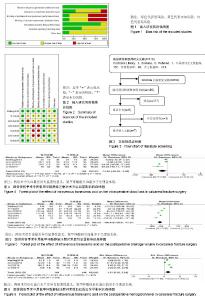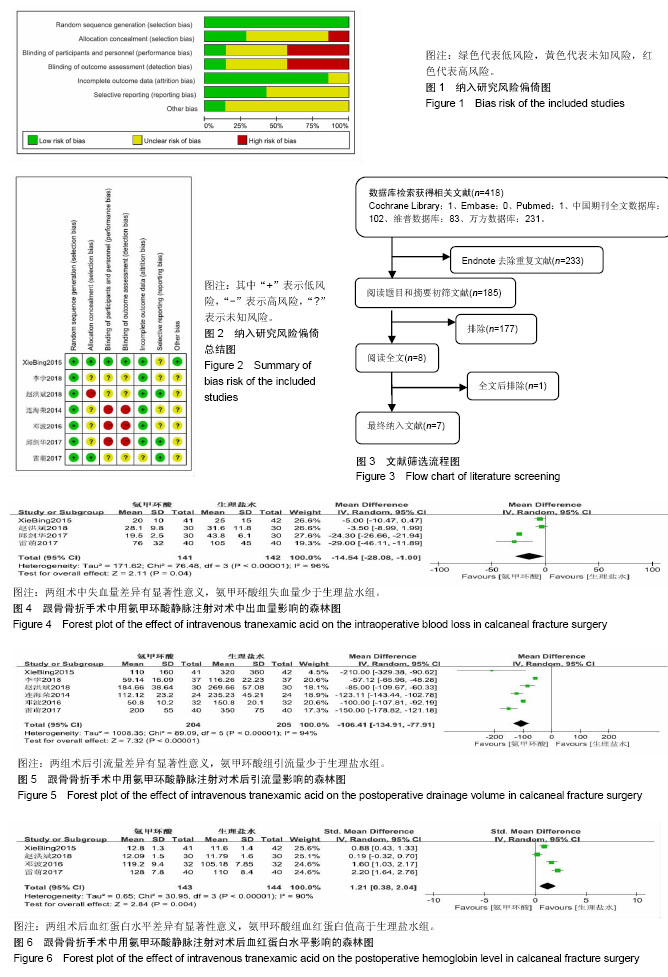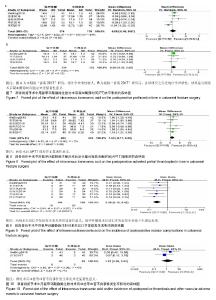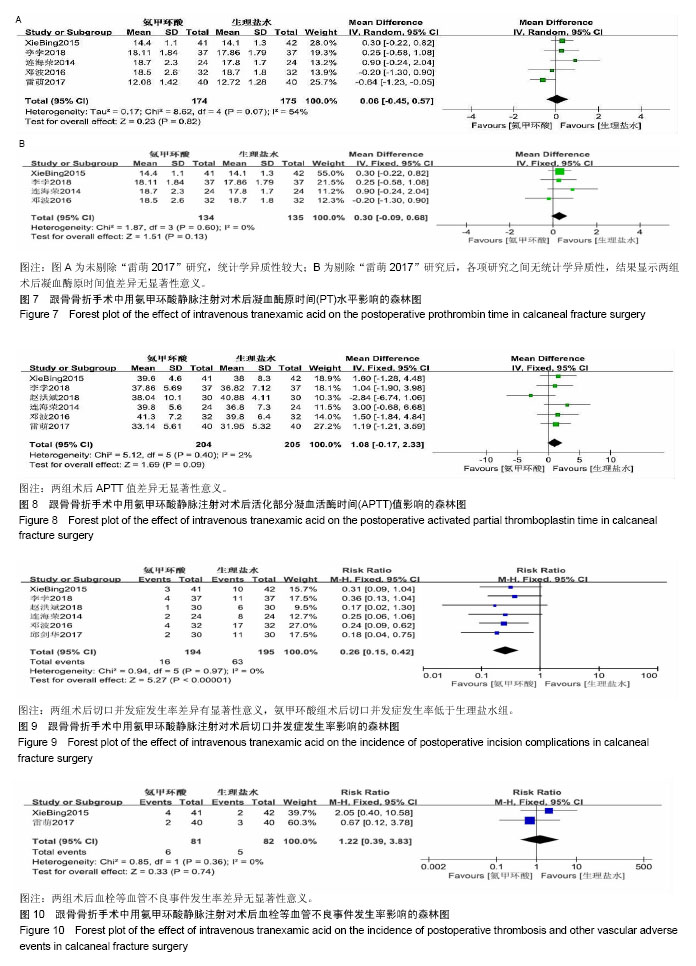Chinese Journal of Tissue Engineering Research ›› 2019, Vol. 23 ›› Issue (20): 3268-3274.doi: 10.3969/j.issn.2095-4344.1190
Previous Articles Next Articles
Efficacy and safety of intravenous tranexamic acid in the operative treatment of calcaneal fractures: a meta-analysis
Zhang Shuai, Ge Wenlong, Li Chang, Han Shichong, Wang Gang, Ren Wenjun
- China-Japan Union Hospital of Jilin University, Changchun 130033, Jilin Province, China
-
Online:2019-07-18Published:2019-07-18 -
Contact:Wang Gang, China-Japan Union Hospital of Jilin University, Changchun 130033, Jilin Province, China -
About author:Zhang Shuai, Master candidate, China-Japan Union Hospital of Jilin University, Changchun 130033, Jilin Province, China
CLC Number:
Cite this article
Zhang Shuai, Ge Wenlong, Li Chang, Han Shichong, Wang Gang, Ren Wenjun. Efficacy and safety of intravenous tranexamic acid in the operative treatment of calcaneal fractures: a meta-analysis[J]. Chinese Journal of Tissue Engineering Research, 2019, 23(20): 3268-3274.
share this article

2.2 Meta分析结果 2.2.1 术中出血量 有4篇文献报告了术中出血 量[6,12,15-16],各研究之间存在统计学异质性(P < 0.000 01,I2=96%),采用随机效应模型进行Meta分析。结果显示:氨甲环酸组与生理盐水组在术中出血量方面的差异有统计学意义[MD=-14.54,95%CI(-25.08,-1.00),P=0.04],氨甲环酸组术中出血量少于生理盐水组,术中应用氨甲环酸可减少术中出血量,见图4。 2.2.2 术后引流量 有6篇文献报告了术后引流量[6,11-14,16],各研究之间存在统计学异质性(P < 0.000 01,I2=94%),采用随机效应模型进行Meta分析。结果显示:氨甲环酸组与生理盐水组术后引流量比较差异有统计学意义[MD=-106.41,95%CI(-134.91,-77.91),P < 0.000 01],氨甲环酸组术后引流量明显少于生理盐水组,见图5。 2.2.3 术后血红蛋白值 有4篇文献报告了术后血常规测定的血红蛋白量[6,11-12,16],各研究之间存在统计学异质性(P < 0.000 01,I2=90%),采用随机效应模型进行Meta分析。结果显示:氨甲环酸组与生理盐水组术后血红蛋白值比较差异有统计学意义[SMD=1.21,95%CI(0.38,2.04),P=0.004],氨甲环酸组患者术后血红蛋白值明显高于生理盐水组,见图6。"


2.2.4 术后凝血功能检测 有5篇文献报告了术后凝血酶原时间(PT)[6,11-14],各项研究之间存在统计学异质性(P=0.07,I2=54%),见图7A,逐个剔除纳入的研究后再重新进行分析,结果显示剔除“雷萌2017”研究后,各项研究之间无统计学异质性(P=0.60,I2=0%),采用固定效应模型进行Meta分析后且各组间结果有统计学意义,说明异质性的来源与“雷萌2017”该项研究差异性较大有关。结果显示:氨甲环酸组与生理盐水组在术后凝血酶原时间值的差异无统计学意义[MD=0.30,95%CI(-0.09,0.68),P=0.13],氨甲环酸组术后凝血酶原时间值与生理盐水组相似,无明显差异,见图7B。 有6篇文献报告了术后APTT值[6,11-14,16],各项研究之间无明显统计学异质性(P=0.40,I2=2%),采用固定效应模型进行Meta分析。结果显示:氨甲环酸组与生理盐水组术后APTT值的差异无统计学意义[MD=1.08,95%CI(-0.17,2.33),P=0.09]。氨甲环酸对凝血系统因子的功能无影响,不增加血栓形成的风险,见图8。 2.2.5 切口并发症发生率 有6篇文献报告了术后切口相关并发症的发生例数[6,11,13-16],各研究之间无明显统计学异质性(P=0.97,I2=0%),采用固定效应模型进行Meta分析。结果显示:氨甲环酸组与生理盐水组的术后切口并发症发生率比较差异有统计学意义[RR=0.26,95%CI(0.15,0.42),P < 0.000 01],氨甲环酸组术后切口并发症发生率显著低于生理盐水组,见图9。 2.2.6 血管不良事件发生率 有2项研究报告了术后血管相关事件的发生率[6,12],研究间无明显统计学异质性(P= 0.36,I2=0%),采用固定效应模型进行Meta分析。结果显示:氨甲环酸组与生理盐水组在术后血管事件发生率方面的差异无统计学意义[RR=1.22,95%CI(0.39,3.83), P=0.74],使用氨甲环酸并不增加血管不良事件的发生率,见图10。 2.3 异质性和敏感性分析 Meta分析结果显示术后引流量的异质性较高,逐个剔除各项研究后再次进行Meta分析,结果仍显示出较高的异质性,且各组间结果有统计学意义,说明关于术后引流量方面此次Meta分析的结果较为可靠,通过重新阅读全文认为术后引流量异质性的来源可能与各个研究间引流量统计时间差异有关;该Meta分析结果示术后血红蛋白水平的异质性较高,逐个剔除纳入的研究后再重新进行分析,结果仍显示出较高的异质性,且各组间结果有统计学意义,说明关于术后血红蛋白水平方面此次分析的结果较为可靠,异质性的来源可能与各个研究间统计单位差异有关。 2.4 发表偏倚分析 使用RevMan软件对文献进行Meta分析时可使用漏斗图进行发表偏倚评价,但Meta分析纳入的研究数不应少于10篇文献,否则会因为纳入的研究数少而导致漏斗图的检验能力下降,以致无法判断不对称性的真实性。而此次研究仅纳入7篇文献,因而未进行发表偏倚漏斗图分析。 "

| [1] 俞光荣,燕晓宇. 跟骨骨折治疗方法的选择[J]. 中华骨科杂志, 2006,26(2):134-141.[2] Bernstein J, Ahn J. In brief: Fractures in brief: calcaneal fractures. Clin Orthop Relat Res. 2010;468(12):3432-3434.[3] Li Y, Bao RH, Jiang ZQ, et al. Complications in operative fixation of calcaneal fractures. Pak J Med Sci. 2016;32(4): 857-862.[4] Rammelt S, Zwipp H. Calcaneus fractures: facts, controversies and recent developments. Injury. 2004;35(5):443-461.[5] Mangram AJ, Horan TC, Pearson ML, et al. Guideline for Prevention of Surgical Site Infection, 1999. Centers for Disease Control and Prevention (CDC) Hospital Infection Control Practices Advisory Committee. Am J Infect Control. 1999;27(2):97-132; quiz 133-134; discussion 196.[6] Xie B, Tian J, Zhou DP. Administration of Tranexamic Acid Reduces Postoperative Blood Loss in Calcaneal Fractures: A Randomized Controlled Trial. J Foot Ankle Surg. 2015;54(6): 1106-1110.[7] Chauncey JM, Wieters JS. Tranexamic Acid. StatPearls. Treasure Island (FL): StatPearls Publishing StatPearls Publishing LLC.; 2018.[8] Mannan S, Ali M, Mazur L, et al. The use of Tranexamic Acid in Total Elbow Replacement to Reduce Post-Operative Wound Infection. J Bone Jt Infect. 2018;3(2):104-107.[9] Yuan C, Wang XM, Yang LJ, et al. Tranexamic acid accelerates skin barrier recovery and upregulates occludin in damaged skin. Int J Dermatol. 2014;53(8):959-965.[10] Fillingham YA, Ramkumar DB, Jevsevar DS, et al. Tranexamic Acid Use in Total Joint Arthroplasty: The Clinical Practice Guidelines Endorsed by the American Association of Hip and Knee Surgeons, American Society of Regional Anesthesia and Pain Medicine, American Academy of Orthopaedic Surgeons, Hip Society, and Knee Society. J Arthroplasty. 2018;33(10):3065-3069.[11] 邓波,方永超,王静成,等. 氨甲环酸在跟骨骨折术的应用价值[J]. 江苏医药,2016,42(17):1931-1933.[12] 雷萌,谢鸣,黄若昆. 氨甲环酸对单侧Sanders Ⅲ~Ⅳ型陈旧性跟骨骨折术后失血量的影响及安全性分析[J]. 足踝外科电子杂志,2017,4(3):6-8.[13] 李孛,苏盛辉,陈峰. 氨甲环酸在跟骨骨折手术中的应用效果分析[J]. 福建医药杂志,2018,40(2):73-76.[14] 连海荣,魏增永,罗建成,等. 氨甲环酸对跟骨骨折术后切口愈合的影响及安全性分析[J]. 山东医药, 2014,54(32):68-70.[15] 邱剑华,陶永承. 氨甲环酸在跟骨骨折手术患者中的应用效果[J]. 临床合理用药杂志, 2017,10(30):88-90.[16] 赵洪斌,陆君安,黎健鹏. 氨甲环酸在跟骨骨折手术治疗中控制出血临床疗效分析[J]. 哈尔滨医药,2018,38(5):419-420.[17] Yu X, Pang QJ, Chen L, et al. Postoperative complications after closed calcaneus fracture treated by open reduction and internal fixation: a review. J Int Med Res. 2014;42(1):17-25.[18] Cavadas PC, Landin L. Management of soft-tissue complications of the lateral approach for calcaneal fractures. Plast Reconstr Surg. 2007;120(2):459-466; discussion 467-459.[19] Su J, Cao X. Risk factors of wound infection after open reduction and internal fixation of calcaneal fractures. Medicine (Baltimore). 2017;96(44):e8411.[20] Soni A, Vollans S, Malhotra K, et al. Association Between Smoking and Wound Infection Rates Following Calcaneal Fracture Fixation. Foot Ankle Spec. 2014;7(4):266-270.[21] Koski A, Kuokkanen H, Tukiainen E. Postoperative Wound Complications after Internal Fixation of Closed Calcaneal Fractures: A Retrospective Analysis of 126 Consecutive Patients with 148 Fractures. Scand J Surg. 2005;94(3): 243-245.[22] Backes M, Spierings KE, Dingemans SA, et al. Evaluation and quantification of geographical differences in wound complication rates following the extended lateral approach in displaced intra-articular calcaneal fractures - A systematic review of the literature. Injury. 2017;48(10):2329-2335.[23] Kim YT, Kang MW, Lee JK, et al. Combined use of topical intraarticular tranexamic acid and rivaroxaban in total knee arthroplasty safely reduces blood loss, transfusion rates, and wound complications without increasing the risk of thrombosis. BMC Musculoskelet Disord. 2018;19(1):227.[24] Della Valle CJ, Buvanendran A, Mont MA, et al. Contemporary Blood Conservation in Hip and Knee Arthroplasty: Tranexamic Acid is an Important Piece of the Puzzle!. J Arthroplasty. 2018;33(10):3063-3064.[25] Amer KM, Rehman S, Amer K, et al. Efficacy and Safety of Tranexamic Acid in Orthopaedic Fracture Surgery: A Meta-Analysis and Systematic Literature Review. J Orthop Trauma. 2017;31(10):520-525. |
| [1] | Wang Jinjun, Deng Zengfa, Liu Kang, He Zhiyong, Yu Xinping, Liang Jianji, Li Chen, Guo Zhouyang. Hemostatic effect and safety of intravenous drip of tranexamic acid combined with topical application of cocktail containing tranexamic acid in total knee arthroplasty [J]. Chinese Journal of Tissue Engineering Research, 2021, 25(9): 1356-1361. |
| [2] | Zhang Chong, Liu Zhiang, Yao Shuaihui, Gao Junsheng, Jiang Yan, Zhang Lu. Safety and effectiveness of topical application of tranexamic acid to reduce drainage of elderly femoral neck fractures after total hip arthroplasty [J]. Chinese Journal of Tissue Engineering Research, 2021, 25(9): 1381-1386. |
| [3] | Chen Junming, Yue Chen, He Peilin, Zhang Juntao, Sun Moyuan, Liu Youwen. Hip arthroplasty versus proximal femoral nail antirotation for intertrochanteric fractures in older adults: a meta-analysis [J]. Chinese Journal of Tissue Engineering Research, 2021, 25(9): 1452-1457. |
| [4] | Chen Jinping, Li Kui, Chen Qian, Guo Haoran, Zhang Yingbo, Wei Peng. Meta-analysis of the efficacy and safety of tranexamic acid in open spinal surgery [J]. Chinese Journal of Tissue Engineering Research, 2021, 25(9): 1458-1464. |
| [5] | Hu Kai, Qiao Xiaohong, Zhang Yonghong, Wang Dong, Qin Sihe. Treatment of displaced intra-articular calcaneal fractures with cannulated screws and plates: a meta-analysis of 15 randomized controlled trials [J]. Chinese Journal of Tissue Engineering Research, 2021, 25(9): 1465-1470. |
| [6] | Huang Dengcheng, Wang Zhike, Cao Xuewei. Comparison of the short-term efficacy of extracorporeal shock wave therapy for middle-aged and elderly knee osteoarthritis: a meta-analysis [J]. Chinese Journal of Tissue Engineering Research, 2021, 25(9): 1471-1476. |
| [7] | Wang Yongsheng, Wu Yang, Li Yanchun. Effect of acute high-intensity exercise on appetite hormones in adults: a meta-analysis [J]. Chinese Journal of Tissue Engineering Research, 2021, 25(8): 1305-1312. |
| [8] | Kong Desheng, He Jingjing, Feng Baofeng, Guo Ruiyun, Asiamah Ernest Amponsah, Lü Fei, Zhang Shuhan, Zhang Xiaolin, Ma Jun, Cui Huixian. Efficacy of mesenchymal stem cells in the spinal cord injury of large animal models: a meta-analysis [J]. Chinese Journal of Tissue Engineering Research, 2021, 25(7): 1142-1148. |
| [9] | Yuan Jun, Yang Jiafu. Hemostatic effect of topical tranexamic acid infiltration in cementless total knee arthroplasty [J]. Chinese Journal of Tissue Engineering Research, 2021, 25(6): 873-877. |
| [10] | Huang Dengcheng, Wang Zhike, Cao Xuewei. Intravenous, topical tranexamic acid alone or their combination in total knee arthroplasty: a meta-analysis of randomized controlled trials [J]. Chinese Journal of Tissue Engineering Research, 2021, 25(6): 948-956. |
| [11] | Li Yan, Wang Pei, Deng Donghuan, Yan Wei, Li Lei, Jiang Hongjiang. Electroacupuncture for pain control after total knee arthroplasty: a meta-analysis [J]. Chinese Journal of Tissue Engineering Research, 2021, 25(6): 957-963. |
| [12] | He Xiangzhong, Chen Haiyun, Liu Jun, Lü Yang, Pan Jianke, Yang Wenbin, He Jingwen, Huang Junhan. Platelet-rich plasma combined with microfracture versus microfracture in the treatment of knee cartilage lesions: a meta-analysis [J]. Chinese Journal of Tissue Engineering Research, 2021, 25(6): 964-969. |
| [13] | Hua Haotian, Zhao Wenyu, Zhang Lei, Bai Wenbo, Wang Xinwei. Meta-analysis of clinical efficacy and safety of antibiotic artificial bone in the treatment of chronic osteomyelitis [J]. Chinese Journal of Tissue Engineering Research, 2021, 25(6): 970-976. |
| [14] | Zhan Fangbiao, Cheng Jun, Zou Xinsen, Long Jie, Xie Lizhong, Deng Qianrong. Intraoperative intravenous application of tranexamic acid reduces perioperative bleeding in multilevel posterior spinal surgery: a meta-analysis [J]. Chinese Journal of Tissue Engineering Research, 2021, 25(6): 977-984. |
| [15] | Xu Jianxia, Wang Zhaoxu, Wang Chunren. Blood compatibility of disposable blood perfusion device in vitro [J]. Chinese Journal of Tissue Engineering Research, 2021, 25(4): 588-592. |
| Viewed | ||||||
|
Full text |
|
|||||
|
Abstract |
|
|||||

